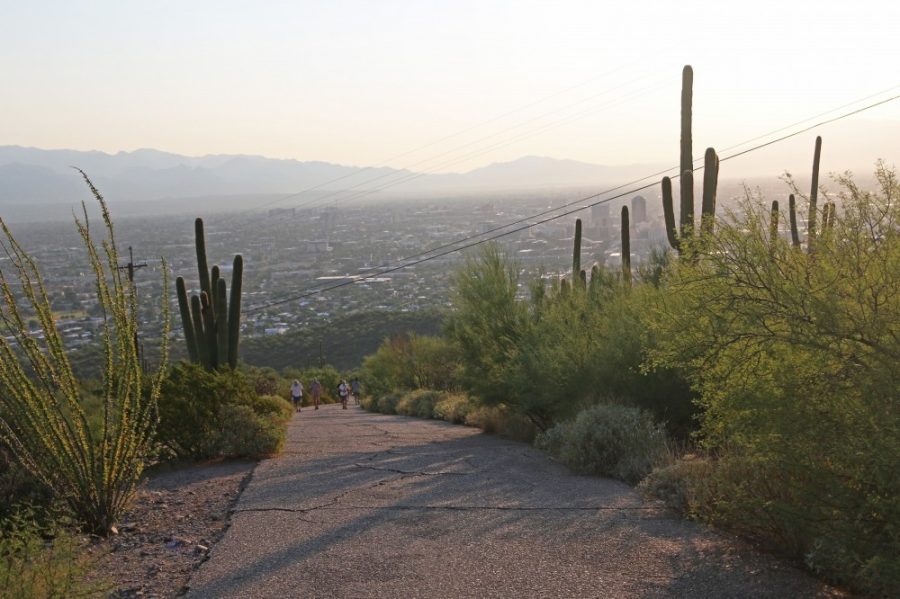It’s no secret that Arizona is hot. Nobody is trying to cover up the fact that Arizona regularly clocks temperatures above 110 degrees every summer, or that the Grand Canyon State not only has the two hottest cities in the United States — Phoenix and Tucson, in that order. It is also home to the highest average temperature location in the country, Lake Havasu City, where a scorching 96.4 degrees is the summer average, according to AZ Central.
And when you think of the places that are the hottest and most unlivable in the state, images of cow skulls and vast arid wastes are immediately conjured in your head. But that image doesn’t take into account the vast amounts of energy given off and used in cities all day and all night, completely changing the natural temperature of the surrounding area in what is called an “urban heat island.”
According to the EPA, these heat islands can make temperatures in cities with over one million inhabitants jump up by as much as five degrees Fahrenheit on an already hot day. The most shocking change is felt at night, where the natural tendency for the land to cool down once the sun goes down is upset by the radiating heat from the city, and it is as much as 22 degrees higher than it otherwise would be.
RELATED: History of rain: How monsoons have shaped desert culture
Heat islands develop as a consequence of human growth and energy consumption, which makes Tucson a relative newcomer to the scene, only recently reaching half a million people. When including surrounding dependencies and other towns, the population approaches almost a million inhabitants.
The National Oceanic and Atmospheric Administration put out a study covering Tucson’s change in weather as the population rose, stating that “urban sprawl and the effects of the associated urban heat island has made it harder to achieve daily low minimum temperature records and nearly impossible to break monthly and yearly low minimum temperature records.” In other words, the once-feasible low temperature of a pretty surprising 6 degrees is unlikely to ever be repeated, and Tucson is likely to only get hotter as the years go on and the community continues to grow.
Tucson’s population has skyrocketed since its early days as a cowpoke railroad stop, jumping from about 7,500 residents in 1900 to just over 212,000 in 1960, more than tripling its population from a decade prior. This incredible jump in energy consumption and human activity can be felt every passing year; in 1960 the average low for a September day was 63 degrees, by 2008 anything under 69 is a true blessing. This increase in average low means Tucson has jumped 6 degrees in temperature as 300,000 more residents call Tucson their home.
So what does this increase mean? The Arizona Republic reported on increasing temperatures and Arizona’s dangerous location in a drought-susceptible and naturally hot region, saying that as temperatures rise, “Phoenix and Maricopa County would suffer 27 more deaths for every 100,000 residents, a body count that would exceed 1,000 a year even at today’s population.” Even further, as national temperatures rise an expected 5 degrees over the course of the century, areas of Arizona are expected to lose as much as 17% of its economic output, putting thousands out of work and depressing the productivity of the entire southwest.
RELATED: OPINION: We need environmental policy that works for everyone
So, what can we do to help negate this seemingly unstoppable force of nature? In a National Science Foundation article titled “Summertime: Hot Time in the City,” professor Sharon Harlan thinks the solution is in urban “cool islands.”
ASU reported that “researchers from CAP LTER [Central Arizona Phoenix Long Term Ecological Research] say we can positively modify our urban environment by incorporating cool, green parks within urban areas. Their studies have found that temperatures are significantly cooler in green parks. Large trees absorb and reflect sun rays, thus causing cooler temperatures.”
There is also the concept for such things as “cool roofs” covered in vegetation and plants that could be installed from high rise to high rise, that would retain rain water and help deflect sunlight that would otherwise be trapped in the urban sprawl.
As Phoenix and Arizona are both victims of the same urban planning crisis to a greater extent than many other regions, it is important for us to lead the pack on breaking the heat island’s constant growth in our expanding cities by organizing more parks in key areas around the city and pushing for the development of cool roofs to counteract the heat from the natural growth of our cities.
Alec Scott is a junior studying Political Science and German Studies who is tired getting heat stroke while walking home. Follow the Daily Wildcat on Twitter









